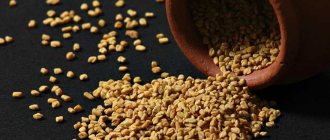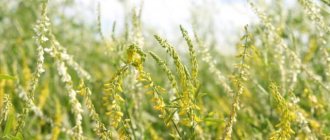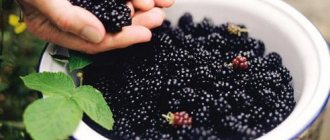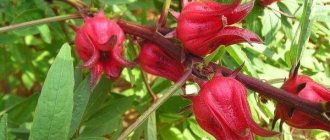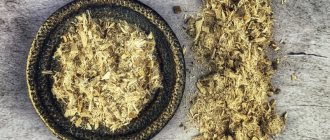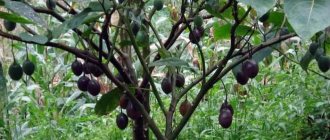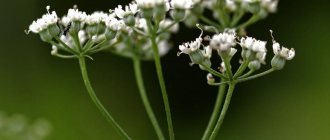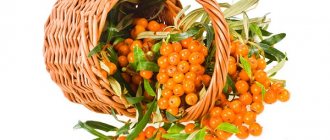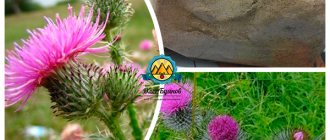Helba is an annual plant of the Legume family. The first information about it was found in the records of the ancient Egyptians dating back to 1550 BC. Helba is mentioned as one of the ingredients in the composition for embalming, anti-burn and to facilitate childbirth. In Ancient Greece, decoctions from the plant were given to gladiators before battles, and the philosopher Avicenna called it his favorite medicinal herb.
Currently, helba is known as fenugreek, shambhala, fenugreek, “Greek hay”, abish, hilbe, Egyptian yellow tea, methi. It is grown in the Caucasus, Eastern Europe, Turkey, Egypt, Saudi Arabia, Ethiopia, and Central Asia.
Collection of cultivated helba
Helba looks inconspicuous. This is a shrub up to 60 cm high with oblong leaves arranged in 3 layers. It has small flowers, from which elongated pods with yellow grains are formed, shaped like pomegranate seeds (see photo).
There are about 100 types of helba in total, the most famous are blue and hay. The first is included in Indian sauces and seasonings, and the second is known as a remedy. It is even mentioned in the Islamic Sunnah as a medicine or “faraj” - the salvation recommended by the Prophet Muhammad.
However, helba is popular not only in the East. It is often found in European traditional medicine recipes, as well as in modern drugs for various diseases. The beneficial properties of the plant, possible harm, options and rules of use are described below.
Beneficial features
The most valuable raw materials of helba are considered to be grains. Refreshing and healing teas, seasonings, and cosmetics are prepared from them. However, the leaves and stems of the plant also provide benefits. They are added to salads, decoctions, and infusions. To understand why the ground part and seeds of helba are known in different parts of the world, just look at the list of positive properties:
- Strengthening the immune system.
- Removal of mucus from the lungs.
- Relieving fever during colds.
- Fight inflammation.
- Reduced blood glucose levels.
- Normalization of the gastrointestinal tract.
- Accelerates the removal of toxins from the body.
- Activation of metabolic processes.
- Eliminate constipation.
- Improving brain function.
- Giving elasticity to blood vessels.
- Reducing the likelihood of developing cancer.
- Activation of the urinary system.
- Reducing nervous tension.
- Improving reproductive function.
- Normalization of blood pressure.
- Accelerating the cell recovery process.
- Activation of hemoglobin production.
- Preventing the formation of blood clots.
- Decreased appetite.
Contraindications and possible harm
Instructions for the use of helba preparations most often indicate that the plant should not be used if you are allergic to the main component. However, the list of contraindications is wider:
- Diseases associated with increased levels of estrogen in the body. The plant activates the production of the hormone, and therefore provokes an exacerbation of the pathology.
- Vaginal bleeding. Helba interferes with the coagulation process and can aggravate the symptom.
- Insulin-dependent diabetes. The herb increases sensitivity to the drug, which leads to the appearance of signs of excess insulin in the body.
Use Helba for the treatment and prevention of pathologies only after consulting with your doctor and calculating a safe daily dose.
If you do not follow the recommendations, helba causes negative reactions:
- reduces the level of male sexual desire due to an increase in the concentration of female hormones in the body;
- causes stomach upset;
- provokes hypotension.
Features of the Egyptian drink
Calling the Egyptian drink tea is not entirely correct. The fact is that it is produced not from the tea bush, but from the seeds of a perennial legume plant - fenugreek. Popularly it has many names, so you can find references to the plant helba, shambhala, chaman, cocked hat, fengugreek and others.
Since ancient times, fenugreek has been used by women to maintain their attractiveness, as well as for weight loss and restoration of the body after childbirth and during lactation.
Despite the fact that fenugreek was widespread in many eastern countries, it was the Egyptians who first made a tonic drink from the seeds, which is why it received the name Egyptian tea
Is it possible for pregnant and lactating women
In the first trimester of pregnancy, as well as when there is a threat of miscarriage, drinking Egyptian tea is strictly contraindicated. Fenugreek beans have the ability to increase progesterone levels, which can cause miscarriage. Before drinking yellow tea in the second and third trimesters of pregnancy, you should consult your doctor.
While breastfeeding, you can drink yellow tea, making sure that the baby is not allergic to this product. To do this, the drink must be introduced into the diet in very small portions. If the child’s body tolerates tea normally, helba with milk should be consumed regularly: this will increase the flow of milk.
Is it possible for children
Fenugreek tea can be given to children over 1 year of age. It helps normalize glucose levels and restore the immune system. The drink is very useful for children during colds. It helps reduce fever and improves well-being. Sometimes helba tea is taken to treat allergies. But in this case, it is extremely important to consult a pediatrician!
Side Effects of Fenugreek Tea
Unfortunately, any tea in large doses can cause negative reactions from the body.
It sometimes causes nausea, sweating, dizziness and hypoglycemia. Even less commonly, Helba tea causes indigestion, diarrhea and motion sickness.
We advise you to read: Taiwanese oolong Dong Ding
Sometimes people even smell maple syrup from their sweat and urine.
Feature benefits for women and men
Some medicinal plants are called “female” or “male”. Helba is universal, equally useful for representatives of the stronger and weaker sex.
Effects on men:
- Infertility. Drinks with shamballa stimulate the production of sperm, improve their quality, and help eliminate inflammation that causes reproductive dysfunction. Take the remedy no more than 3 times a day.
- Potency. The plant contains substances that stimulate the production of testosterone and relieve genitourinary diseases. To maintain potency, drink tea from the seeds 3 times a day, 200 ml, or take 2 tablespoons of powder mixed with a glass of milk.
- Physical exhaustion. Helba tones the body, relieves insomnia, and helps restore strength. To recover after hard work, drink a cup of tea. Sprouted seeds help get rid of muscle pain and activate growth.
Useful properties of helba for women, how best to take it:
- Increased lactation. Promotes the production of prolactin, so during breastfeeding you can drink a cup of bean tea once every 2 days.
- Reducing symptoms of PMS and menopause. Phytohormones contained in the plant help reduce uterine spasms during menstruation and eliminate estrogen imbalance during menopause. Relieves pain during menstruation and helps regulate the cycle. The sedative and anti-inflammatory effects of helba contribute to improving women's health. Drink 1 cup of seed tea 3 times a day.
- Breast augmentation. One of the factors influencing bust size is high estrogen content. Helba stimulates hormone production and is used to maintain breast beauty. According to women, the bust becomes larger with regular consumption of sprouted or roasted seeds of the plant.
- Vulvitis. For inflammation of the external genitalia, douching and hygiene procedures with helba infusion stimulate the restoration of damaged tissue, block the spread of infection, and relieve itching and discomfort.
- Infertility. The plant helps speed up conception because it activates the work of the ovaries. To get pregnant, take Helba tea before ovulation or after menstruation.
Application
Here is a list of diseases that can be treated with Helba tea. Data taken from official reports of the World Health Organization. So, the diseases for which this drink helps include:
- Diabetes mellitus type 1. Bitter substances in helba seeds reduce the amount of glucose. Regular consumption of tea regulates sugar levels.
- Urolithiasis. It is important to know that the decoction has a diuretic effect. It also removes sand from the kidneys. Relieves inflammation.
- Normalizes the functioning of the gastrointestinal tract. Tea envelops the walls of the mucous membrane and heals inflammation.
- Helps with regular consumption of spicy foods and alcohol.
- In addition, it relieves the symptoms of ulcers and gastritis.
- It is also an antipyretic.
- In addition, it reduces blood pressure. Recommended for arterial hypertension. Thins the blood and dilates blood vessels.
- Has a calming effect. In addition, it fights insomnia, anxiety and neuroses.
- It is important to note that tea normalizes hormonal imbalance during pregnancy. And also after childbirth and during menopause.
- Among other things, tea helps restore strength after illness or surgery.
We advise you to read: The best recipes from your grandmother for coughs and lung diseases with aloe and honey
Pregnant and lactating women, research
Helba is not recommended for use during pregnancy. The plant stimulates uterine contractions and can cause miscarriage. Doctors believe that Shambhala makes childbirth easier. However, if bleeding occurs, it becomes dangerous because it slows down the resolution of the problem.
When breastfeeding, teas with helba are used to enhance lactation. The effectiveness of the product among women is proven by studies by Palestinian scientists. In 2021, they published the results of work aimed at collecting feedback from gynecologists and nursing mothers about the plant’s effect on the rate of breast milk formation.
Experts have found that drinks with helba increase lactation and can also bring not only benefits, but also harm.
Pros:
- accelerating the body's recovery after childbirth;
- normalization of digestion;
- increasing the volume of breast milk;
- antioxidant effect;
- improving the body's defenses;
- breast cancer prevention;
- eliminating constipation;
- normalization of hormonal levels.
Disadvantages of the plant that appear when used incorrectly:
- decreased blood clotting rate;
- possible worsening of asthma symptoms;
- provoking nausea, vomiting, diarrhea;
- sweating;
- mastopathy.
Experts concluded that the possibility of using helba during breastfeeding should be discussed individually with a doctor. Women must be warned about side effects and the acceptable dosage must be selected.
"Women's Medicine"
Helba has long had a reputation as a “women’s healer.” It is used to treat infertility, many gynecological diseases, to facilitate childbirth, enhance lactation, prevent breast cancer, with painful menstruation, PMS and to relieve menopausal symptoms.
Modern researchers explain the effectiveness of helba in the fight against female ailments by the presence of diosgenin in it - when it enters a woman’s body, it eliminates hormonal imbalance and tones the hormonal system.
Chemical composition, calorie content
It contains an impressive set of active compounds:
- tannins;
- essential oils;
- saturated fatty acids;
- coumarins;
- antioxidants;
- flavonoids;
- saponins;
- phytoestrogens;
- enzymes;
- alkaloids;
- amino acids;
- polysaccharides;
- resins;
- vitamins A, B1, B2, B6, B9, C, P, PP, D.
List of micro and macroelements:
- iron;
- calcium;
- potassium;
- magnesium;
- selenium;
- sodium;
- zinc;
- phosphorus;
- copper.
Calorie content of 100 grams of grains is 323 kcal. They are saturated with proteins 25-30%, fats – 6%, carbohydrates – about 20%. The nutritional value of the leaves is 35 kcal per 100 grams. Greens have a spicy aroma and contain a large amount of fiber.
Recommendations from nutritionists for losing weight
According to nutritionists, helba is useful for losing weight. Promotes processes that accelerate weight loss:
- normal metabolism;
- eliminating food cravings;
- cleansing the intestines;
- removing excess fluid.
To lose weight and not gain kilograms again, make drinks without sugar, eat right after stopping the diet, and do not forget about physical activity.
When losing weight, use the following rules of admission:
- prepare tea from ground beans;
- consume no more than 2 glasses of the product per day, divided into 4 doses;
- drink one hour before meals;
- To speed up weight loss, add ginger to tea.
Often in diets it is recommended to use curry instead of salt, which is often made on the basis of an analogue of turmeric - helba. For example, the heroine of American films, Barbra Streisand, conducts a 13-day nutrition course for herself every six months, taking into account this restriction.
Classic recipes for brewing Helba tea
Tea acquires beneficial properties only when properly prepared. You can brew the drink in several ways:
- In a thermos. Take 2 teaspoons of seeds, pour into a container, fill with water heated to 70 degrees. Close the thermos with a lid and leave for 10 minutes. The drink has a spicy aroma and a yellow tint. This tea is not concentrated, therefore it is used as a prophylactic against colds and flu, and for the treatment of chronic stomach pathologies.
- Steaming. The drink is recommended for cleansing the intestines and eliminating constipation. To prepare, use 15 grams of ground beans per 200 ml of hot water. Fill the seeds with liquid and leave to infuse overnight. In the morning, strain and drink an hour before breakfast.
- From leaves. Herbal tea helps eliminate pain during menstruation and inflammation of the pelvic organs. To brew, take 2 tablespoons of leaves and pour 0.5 liters of hot water. Heat the liquid in a steam bath for 5-7 minutes, cool at room temperature, and strain. Drink 100 ml of the drink 2-3 times a day.
- For men's health. We prepare a mixture of 1 part helba seeds, 1 part calamus root, 2 parts yarrow. Pour 1 tablespoon of the composition into a thermos, pour a glass of water (70 degrees), leave for 7 minutes. Drink 1 glass of tea 3 times a day for 3 weeks.
The video also demonstrates a quick method for brewing helba with milk.
Recipe for bust enlargement
To enlarge the breasts, use Helba in several options:
- adding grain powder to food;
- rubbing in medicated oils;
- use of decoctions.
The latter technique is the most popular, since at the same time as improving the bust of girls, they treat female diseases.
Recipe:
- wash the seeds;
- dry the raw materials in a frying pan until a golden hue appears;
- Pour 2-3 teaspoons into a deep container and fill with hot water;
- cook in a steam bath or low heat for 5-6 minutes.
Drink 1 cup 3 times a day.
Helba - seeds: use and contraindications
What else is helba (fenugreek, shambhala) useful for? The beneficial properties and contraindications for the use of seeds should be taken into account, and if you have an individual intolerance, avoid using them! In addition, do not use helba without consulting a specialist if you have:
- type 1 diabetes;
- asthma;
- malignant or benign tumors;
- hormonal imbalance with increased sex hormones;
- bleeding disorders.
But in what cases will helba be beneficial:
- for pathologies of the cardiovascular system;
- for diseases of the genitourinary system and kidneys;
- with high cholesterol;
- for gastrointestinal diseases and digestive disorders;
- with low metabolism;
- in case of violation of the body’s defenses and vitamin deficiency;
- as an expectorant and diaphoretic;
- as a remedy for fever;
- as a general tonic during acute respiratory infections and flu, etc.
Useful recipes with fenugreek for various ailments:
- To cleanse the intestines, boil helba oil with honey and take it orally. The same recipe is effective for inducing menstruation and also for hemorrhoids.
- Infusion for gargling for a sore throat. In half a liter of water, simmer 2 tablespoons of fenugreek seeds over low heat and let it brew for 20 minutes. Filter, cool and gargle every 1-3 hours if possible.
- For tuberculosis, bronchitis and other diseases of the lower respiratory system, it is recommended to take this decoction: boil 2 teaspoons of fenugreek seeds in a glass of water for 10 minutes, adding a few dates or a little figs with honey. Drink ½ stan up to 4 times a day.
- This recipe will help you get rid of a dry, lingering cough: boil a tablespoon of ground helba seed in a glass of milk. Leave for half an hour, filter and drink half a glass before meals.
- For anemia, it is useful to take a paste of twisted dates, figs, raisins and helba (in equal parts) with honey.
- For sinusitis, it is useful to use helba in this form: the seeds are steamed in boiling water at the rate of a tablespoon per glass of water. Then evaporate over low heat until the volume of liquid is reduced by half. Drink half a glass three times daily.
The benefits and harms of helba for diseases
The plant has a wide list of indications for use. However, for each disease, take into account the specific effects of helba on humans:
- Angina. Gargling with a concentrated decoction speeds up recovery because it stops the spread of infection and relieves inflammation and pain. During treatment, avoid swallowing the drink, since it is prepared at the rate of 50 grams of beans per 500 ml of water. This concentration is useful when used topically, but if ingested it causes diarrhea and allergies.
- Bronchitis. Herbal tea promotes the release of phlegm, reduces fever, and activates the body's defenses. The result of the treatment appears faster if the helba is brewed in a thermos in equal parts with thyme and marshmallow root, filled with hot water. Take 1 tablespoon of the product up to 8 times a day. You cannot drink the entire dose at once, as it can provoke an allergy and a severe coughing attack.
- Stones in the kidneys. A decoction of dates and helba seeds eliminates congestion in the kidneys and reduces the likelihood of exacerbation of the disease. To prepare, we use 5-6 fruits, 0.5 teaspoon of grains, 400 ml of water. Cook over low heat until 1/3 of the liquid has evaporated, strain after cooling. Drink 100 ml 3 times a day. The drug should not be taken during an exacerbation of urolithiasis, since the active functioning of the excretory system creates a dangerous load on the kidneys.
- Prevention of heart disease. Tea made from grains and leaves reduces cholesterol levels, prevents the formation of blood clots, eliminates the risk of stroke, and improves the condition of the heart muscle. Restriction on the consumption of drinks - pathologies accompanied by low blood pressure.
- Haemorrhoids. Helba eliminates one of the main causes of inflammation – constipation. During treatment, it is recommended to drink tea in the morning on an empty stomach. If the pathology is advanced and surgical intervention is necessary, consult a doctor.
- Anemia. A drink of 1 teaspoon of grain powder, 1 glass of milk and a spoon of honey helps to compensate for the lack of iron. Drink the product no more than 2 times a day; increasing the dose will lead to bloating and diarrhea.
- Sinusitis. Inflammation of the paranasal sinuses is eliminated using a decoction of seeds made from 1 teaspoon of raw materials and 250 ml of water. The patient gets better if he drinks 2 cups of liquid per day. The product can only be used to treat adults. The decoction will cause stomach upset in a child.
- Arthritis. Reduction of inflammation and joint pain is accelerated by a remedy prepared according to this recipe: 3 tablespoons of ground grains, pour 500 ml of cold water, leave for 3 hours. Bring the resulting liquid to a boil and strain. We take 50 ml 3 times a day. To enhance the effect, add honey.
- Prevention of gastritis, heartburn. Helba relieves irritation of the gastric mucosa. Unpleasant symptoms can be avoided if you eat food seasoned with 1 teaspoon of plant powder once a day. Avoid combining with products that have a laxative effect.
- Skin diseases. Helba-based ointment helps against rashes, boils, purulent wounds, fistulas, and calluses. Preparation: in an enamel container, mix the powder with water until the consistency of sour cream is formed. With continuous stirring, heat the resulting mixture over low heat for 10 minutes. Let the product cool, apply to the inflamed area, and cover with a gauze bandage. Leave for 2 hours, rinse with warm water. Cannot be used if you have allergies.
- Hepatitis. Helba prevents the destruction of liver cells, activates the removal of toxins, and improves the composition of bile. For treatment, it is recommended to brew and drink tea from seeds roasted until brown.
- Worms. The herb accelerates the elimination of waste products of parasites and helps to avoid complications caused by the presence of helminths. Infusions are used for therapy, and medicinal tea is used for prevention.
Diabetes mellitus, research
In 2013, employees of a medical college in India conducted a study on the effect of helba seeds on stage 2 diabetics. 60 patients who were diagnosed with pathology 6 months before the start of the experiment were selected for work. The subjects were divided into 2 groups. The first, in addition to the main treatment, received 10 grams of seed powder daily, the therapy of the second was limited to standard methods.
A study found that taking the herbal remedy accelerates the reduction in blood sugar levels. However, scientists noted: the indicator changes gradually, and to achieve tangible results, the use of helba should last 6 months.
Experts recommended the plant as an adjuvant in the treatment of insulin-independent diabetes mellitus and the prevention of pathology.
Application in cosmetology
Scientists from Asia and Africa have written entire books explaining what helba is and how to use it. The works contain sections on the use of plants in cosmetology. Homemade and industrial products are prepared from it to strengthen hair, rejuvenate the face, and correct body shape. Below are the beauty product options.
Face masks
For facial care, grain-based masks are used. Recipes:
- Cleansing. To get rid of dermatitis, acne, inflammation, take 1 teaspoon of seed powder and mix with 1 tablespoon of olive oil. Apply for 10 minutes 2-3 times a week.
- Nutritious. The mask restores skin elasticity, prevents drying and flaking. To prepare, take a teaspoon each of ground seeds, honey, olive and caraway oil. Mix the ingredients with the yolk until a homogeneous mass is formed. Apply several times a week for 15 minutes, rinse with warm water.
- Moisturizing. Combine the powder with carrot juice, honey and aloe juice in equal parts. Apply for 20 minutes 2 times a week.
- Regenerating. To restore skin and rejuvenate, prepare a mixture of 80 grams of rice flour and 30 grams of crushed grains. Add enough water to make a creamy mass. Apply to face every 2-3 days, wash off after drying.
For hair
Hair grows faster, becomes strong and shiny if you use the following products:
- Infusion for rinsing. Pour 1 teaspoon of grains into a glass of hot water and leave for 60 minutes. We rinse our hair with the resulting liquid after each wash or treat it with a spray bottle during the day, 2 times a week.
- Hair strengthening mask. Mix 30 grams of powder with 200 ml of water and cook until a paste forms. Apply the resulting product to the hair roots, gently rubbing into the skin. Leave for 20 minutes, rinse with shampoo.
- Anti-dandruff mixture. Combine 1 teaspoon each of ground helba, olive and caraway oils, add a pinch of black pepper. Rub the mixture into the skin and wrap your head with a towel. Leave it on for 30 minutes and wash it off. We repeat the procedure 3 times a week.
Oil for breast shape correction
To improve the shape of the bust, mix 50 ml of linseed oil and 8 drops of helba oil. Rub in a circular motion into the chest area counterclockwise. After 5-7 minutes we take a contrast shower. Repeating the procedure every 3 days makes the bust elastic and promotes enlargement.
How to brew Helba tea
The drink known as Helba tea is famous. Its beneficial properties include a general strengthening and tonic effect on the body. The preparation of this tea differs from the classical method, and the taste is also different.
So, this is how tea is prepared. Fenugreek seeds are washed and dried thoroughly. After that, they are roasted, like coffee. A dry frying pan is suitable for this. The uniform golden hue of the seeds will indicate the readiness of the helba. You shouldn’t wait until it turns red – the drink will turn bitter. Then the seeds are crushed, take a teaspoon of powder for each glass of water. The drink is not brewed, but boiled over medium heat for 7-10 minutes. Then you can immediately pour it into tea cups and enjoy the unusual taste.
Be prepared that you may not like the smell at first. It takes time to get used to it. To soften the taste, you can add honey to tea. The drink will be healthier if you add ginger to it.
In what form is it sold, how to choose
The pharmacy sells the following types of products:
- seeds in cardboard packages, paper bags, glass jars;
- oil in bottles of 30, 50, 100, 125, 200 ml;
- capsules with crushed grains.
- seed powder for making tea, packaged in paper bags, small containers.
When choosing a product, pay attention to the following points:
- High-quality grains have a golden-brown hue and look “full.” Dark and dried out seeds indicate that they have not been stored properly or are past their expiration date.
- The oil is transparent, golden in color, without flakes or dark sediment.
- When choosing capsules, pay attention to the shelf life. Discard medications that have less than 30 days left before their final sales date.
- Buy the powder hermetically sealed. Once the package or jar is opened, use within 3 months.
Use in cooking
For Europeans, helba is most often found in oriental seasonings: curry and hops-suneli. It is added to meat dishes, fish, salads, and soups. However, residents of Asia and Africa use the plant in sweets, baked goods, and drinks. For example, in Egypt they make bread called “khulba”, and in Greece a popular dish is made from helba seeds and honey. The grain powder is also used to flavor cheeses, sauces, and snacks.
What is “yellow tea from Egypt”?
Let's figure out what Egyptian yellow tea is. Let's find out its beneficial properties, how to brew it correctly and where to buy it.
Yellow tea is not actually tea. It has nothing to do with the leaves of the tea bushes, from which the drink familiar to almost the entire world is produced.
Egyptian yellow tea is made from the seeds of the fenugreek plant. It is also called shambhala, helba, camel grass, abish, chaman, etc. Fenugreek belongs to the legume family. It is used in medicine and cooking in China, India, Ethiopia, South America and other regions.
Since ancient times, people have known and appreciated the beneficial properties of fenugreek. It was brewed, made into infusions, ground and added to food and medicine. Fenugreek was considered indispensable for women's diseases, colds, problems with potency, during the recovery period after long-term illnesses, and for cleansing the skin. And this is not a complete list of problems that fenugreek helps solve.
In Egypt, tourists are often offered to taste yellow tea. There is no point in refusing. At first glance, unbrewed yellow tea seems strange: not dry leaves, but something like cereal. And they brew it completely differently from regular tea. But the amazing aroma, unusual taste and benefits for the whole body make this tea an indispensable drink for health.
Helba
Helba grows in the Middle East and Egypt. But the slopes of Tibet are considered the birthplace of culture. This plant is popularly called fenugreek. Its stems grow up to 60 centimeters in height. It blooms once a year with small single flowers. Flowers are yellow or lilac.
Just after flowering, oblong beans ripen on the helbe. They form seeds that contain minerals. As well as medicinal substances and vitamins. It is from the seeds that healing herbal tea is made.
Fenugreek
Its name comes from the Latin trigonella foenum-graecum and means "Greek hay." The plant has long been used mainly as animal feed.
However, you've probably already come across its other names. For example, fenugreek, helba, shambhala, methi, etc. And all the names are quite interesting!
Fenugreek now grows in the Mediterranean region, North Africa and India. From here it spread to some extent to the rest of the world. But India alone remains the largest producer of fenugreek.
Helba reaches a height of 60 cm. The plant has long stems and bright green leaves. In summer it blooms with white and light yellow flowers. And from the flowers come small pods with a large number of seeds.
Throughout history, both the leaves and seeds of the grass have been used equally. Spices were prepared from them to enhance the taste of food. And in herbal medicine they generally received a special place.
However, the seeds are now most prized. They are brownish to yellow in color and tiny in size. They have a spicy, unusual pungent smell. They are usually dried and roasted and then ground into a powder.
History of Fenugreek
Back in the times of ancient Rome, Greece and Egypt, fenugreek was already highly valued. Firstly, it was used to season many dishes. And secondly, its medicinal use for stomach problems was famous.
In India, fenugreek was added to curry powder. And not only! It was also often found in other spice mixtures. In Ayurveda, it was an aphrodisiac and herb for rejuvenation and complete cure of all diseases.
Heading further east we reach China. Here too, fenugreek is traditionally used to treat a number of diseases. Helba tea is brewed for kidney and liver diseases. And a particularly valuable place is given to the ability to regulate the male and female hormonal balance of the body.
Today, fenugreek maintains its culinary reputation throughout the world. The seeds are added to salads and seasoned in stews and soups. Many dishes with fenugreek acquire a special aroma. And like maple, fenugreek is sometimes used to flavor candies.
As for Helba’s medical reputation, we will describe everything in detail below.
Where is tea grown?
It is grown in Egypt. The peculiarity and main difference of this tea is that it is made from fenugreek seeds, and not from the leaves of the tea bush. This plant has many names. So, if they tell you that yellow Egyptian tea is made from blue sweet clover, shamballa, hilbe (helba), fenugreek, camel grass, then know that this is the same plant.
Fenugreek is an annual plant of medium height (from 40 to 70 cm), from the pods of which the seeds are obtained. Tea is then made from them, but first they are washed and dried well.
Camel grass seeds have a very piquant, unique aroma - it contains nutty, chocolate, and vanilla notes. It was due to the unique smell of blue clover seeds that Egyptian chefs began to use them for culinary purposes, adding them to curry seasoning and also to suneli hops.
By the way, this plant is grown not only in Egypt. Shambhala also grows in China, India, South America, some African and European countries, and the Transcaucasus. Shambhala seeds, by the way, look like our buckwheat.
We recommend reading: List of the most expensive teas in the world: Da Hong Pao, Puer and others
In addition to the pleasant taste and amazing aroma, this yellow tea also has beneficial properties. Hippocrates and Avicenna, as well as other ancient healers, used this plant for medicinal purposes. Want to know the benefits of this drink? Then check out its amazing lineup.

